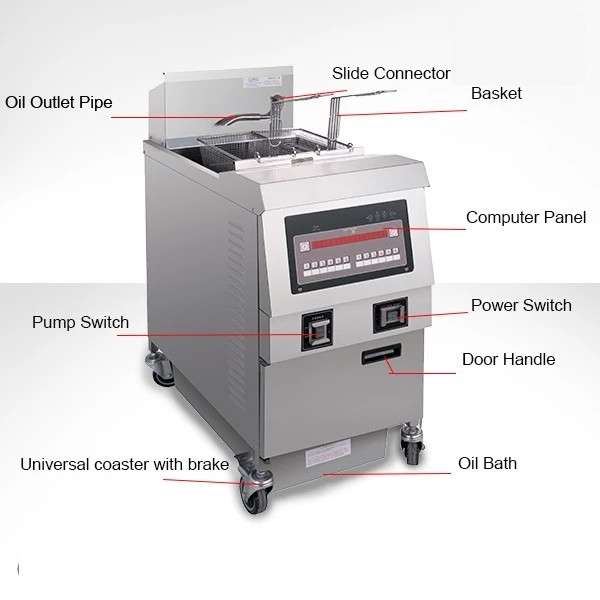How do you use a commercial chip/deep fryer?
Mastering the Commercial Chip Fryer: A Comprehensive Guide
Using a commercial chip/deep fryer is an essential skill for anyone involved in the culinary industry, particularly in establishments specializing in fast food or fried dishes. This guide aims to provide a detailed overview of the proper operation and maintenance of a commercial chip fryer to ensure food safety, efficiency, and longevity of the equipment.
Understanding the Commercial Chip Fryer
A commercial chip fryer is a high-capacity appliance designed to deep-fry large quantities of food, such as chips (fries), quickly and efficiently. It typically consists of a large oil vat, heating elements (either electric or gas-powered), a basket for holding the food, a temperature control system, and a draining mechanism for oil maintenance.
Preparing the Fryer
1. **Positioning the Fryer**: Ensure the fryer is placed on a stable, level surface, preferably under a ventilation hood to manage steam and fumes. It should be in a well-ventilated area away from flammable materials.
2. **Filling with Oil**: Choose a high-quality frying oil with a high smoke point, such as canola, peanut oil or palm oil. Fill the fryer to the designated fill line to prevent overflow and ensure even cooking.
3. **Setting Up**: Check that all parts, including the fryer basket and oil filter, are clean and properly installed. Make sure the power supply is secure for electric fryers or that the gas connections are leak-free for gas fryers.
Operating the Fryer
1. **Preheating**: Turn on the fryer and set the thermostat to the desired temperature or select the menu key, typically between 350°F and 375°F (175°C – 190°C) for frying chips. Allow the oil to heat up, which usually takes about 6-10 minutes. A ready light indicator will signal when the oil has reached the correct temperature. If it is an automatic lifting deep Fryer, the basket will automatically down when the time is set.
2. **Preparing the Food**: While the oil is heating, prepare the chips by cutting potatoes into even-sized pieces. For best results, soak the cut potatoes in water to remove excess starch, then pat them dry to avoid water splashing into the hot oil.
3. **Frying the Chips**:
– Place the dried chips into the fryer basket, filling it only halfway to ensure even cooking and prevent oil overflow.
– Slowly lower the basket into the hot oil to avoid splashing.
– Cook the chips for 3-5 minutes or until they achieve a golden-brown color and crispy texture. Avoid overcrowding the basket as this can lead to uneven cooking and lower oil temperature.
4. **Draining and Serving**: Once the chips are cooked, raise the basket and let the oil drain back into the fryer. Transfer the chips to a paper towel-lined tray to absorb excess oil, then season and serve immediately for best taste and texture.
Safety Measures
1. **Monitoring Oil Temperature**: Regularly check the oil temperature to ensure it remains within the safe frying range. Overheated oil can cause fires, while underheated oil can result in greasy, undercooked food. MJG OFE series of open fryers use an accurate temperature control system with ±2℃. This system provide customers with precise, consistent taste and ensuring optimal frying results with minimal energy consumption.
2. **Avoiding Water Contact**: Water and hot oil do not mix. Ensure food is dry before frying, and never use water to clean a hot fryer as this can cause dangerous splattering.
3. **Using Protective Gear**: Wear heat-resistant gloves and an apron to protect against oil splashes and burns. Use appropriate utensils(OFE series of open fryer with automatic lifting), such as metal tongs or a skimmer, to handle food in the fryer.
Maintaining the Fryer
1. **Daily Cleaning**: After the open fryer has cooled down, filter the oil to remove food particles and debris. Clean the frying basket and wipe down the exterior of the fryer. Some fryers have a built-in filtration system that makes this process easier.One of the key features that our open fryers is the built-oil filtration systems. This automatic system helps extend oil life and reduces the maintenance required to keep your open fryer functioning.
2. **Regular Oil Changes**: Depending on the frequency of use, change the oil regularly to maintain food quality and fryer efficiency. Signs that oil needs changing include a rancid smell, excessive smoking, and a dark color.
3. **Deep Cleaning**: Schedule periodic deep cleaning sessions where you drain the fryer completely, clean the oil vat, and check for any wear or damage to components. Replace worn-out parts to prevent equipment failure.
4. **Professional Servicing**: Regularly service the fryer by a qualified technician to ensure it remains in optimal working condition and to address any potential issues before they become major problems.
Conclusion
Using a commercial open fryer effectively involves understanding the equipment, following proper procedures for frying, adhering to safety protocols, and maintaining the fryer to ensure longevity and performance. By mastering these aspects, you can produce consistently high-quality fried foods that will satisfy customers and contribute to the success of your culinary establishment.
